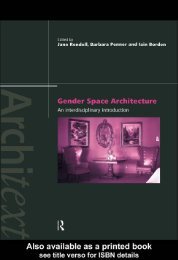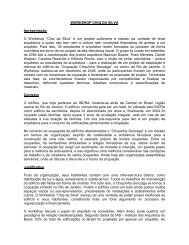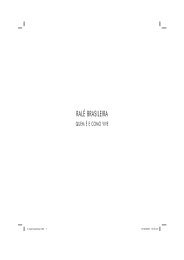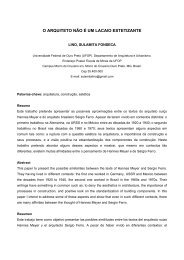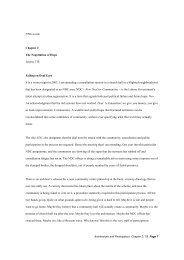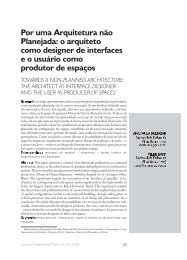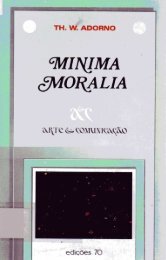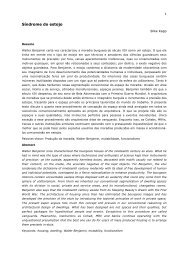Architecture and Modernity : A Critique
Architecture and Modernity : A Critique
Architecture and Modernity : A Critique
You also want an ePaper? Increase the reach of your titles
YUMPU automatically turns print PDFs into web optimized ePapers that Google loves.
222<br />
223<br />
Such anamnestic thought is tried out in his essay “Domus <strong>and</strong> the Megalopo-<br />
lis.” Lyotard describes the condition of the domus as one that has now become im-<br />
possible: dwelling as a commonplace where a desire to serve <strong>and</strong> a concern with the<br />
community are at work. This domestic community belongs to the past, for the human<br />
world has become a megalopolis. “From after the death of Virgil. From after the<br />
end of the houses. At the end of the Buddenbrooks.” The prevailing system orchestrated<br />
by the exchange principle is not the least bit concerned with habit, narrative,<br />
or rhythm. Its memory is dominated by the principle of rationality that tramples tradition<br />
underfoot. The domus, however, concealed behind this system, does leave<br />
some trace of itself. This makes it a fata morgana for us, the impossible dwelling.<br />
Thought that attempts to resist incorporation by the megalopolis appears as the<br />
h<strong>and</strong>writing of these impossible dwellings: “Baudelaire, Benjamin, Adorno. How to<br />
inhabit the megalopolis? By bearing witness to the impossible work, by citing the lost<br />
domus. Only the quality of suffering counts as bearing witness. Including, of course,<br />
the suffering due to language. We inhabit the megalopolis only to the extent that we<br />
declare it uninhabitable. Otherwise we are just lodged there.” 6 This impossible notion<br />
is for Lyotard what is at stake in thinking, in writing, <strong>and</strong> in works of art. It also<br />
forms, in my opinion, what is at stake in architecture. The Jewish Museum in Berlin<br />
is an example of the way in which architecture, “after Auschwitz,” can rewrite the<br />
meaning of modernity. “Auschwitz” st<strong>and</strong>s for the ultimate uninhabitability of<br />
modernity. The impossibility of dwelling, the bankruptcy of modernity’s promise of a<br />
new Heimat is given architectonic form in the cold <strong>and</strong> gloomy depths of Libeskind’s<br />
voids. Out of the intertwining of the two lines <strong>and</strong> the play of space, light, <strong>and</strong> texture,<br />
something else appears: what is involved here is not only despair <strong>and</strong> mourning;<br />
it is also hope for the future that can take shape only through a lucid grasp of the<br />
hopelessness of the present. It is here that Libeskind’s critical reworking of the<br />
legacy of the Enlightenment lies. Rewriting modernity means a face-to-face confrontation<br />
with its failures <strong>and</strong> perversities; an anamnesis of the past is the precondition<br />
for taking any step into the future.<br />
Koolhaas is less urgently concerned with reworking the past. Even so, the<br />
mimetic strategy of the Sea Terminal provides us with a work that in its “inevitable<br />
transformation into a cultural commodity” is witness to “the impossibility of the<br />
work,” as Lyotard would have it. 7 This project refuses to choose between a banal<br />
commercial logic <strong>and</strong> the aspirations of art. Both are at issue here, both are equally<br />
valid. They are inseparably entwined, without being totally fused. It is precisely in the<br />
chasm between them that the “margin” exists that forms the tension of the design.<br />
In the intertwining of complicity with the system <strong>and</strong> opposition to the leveling tendencies<br />
inherent in it, the project of rewriting modernity is given form.<br />
“To inhabit the megalopolis by declaring it uninhabitable.” This is a way of<br />
rewriting Benjamin’s formula in which he calls for a new sort of dwelling, a dwelling<br />
that is appropriate to the “hurried actuality” of the present. In addition to the age-old<br />
sense of security <strong>and</strong> seclusion, dwelling takes on a new level of meaning that has



